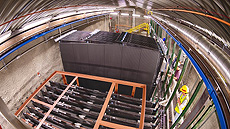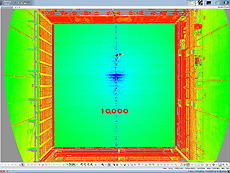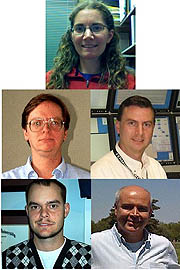|
Thursday, Dec. 12
- Breakfast: Canadian bacon, egg and cheese Texas toast
- Breakfast: corned-beef hash and eggs
- Carolina pulled-pork sandwich
- Mediterranean-style ziti with asparagus
- Honey baked ham
- Buffalo chicken tender wrap
- Pasta bar
- White-chicken chili
- Chef's choice soup
Wilson Hall Cafe menu |
|
Saturday, Dec. 14
Dinner
Guest chef: Grace Leonard
- Assortment of small plates, tapas style
Wednesday, Dec. 18
Lunch
- Salmon Wellington
- Parmesan orzo
- Lemon berry Napoleon
Chez Leon menu
Call x3524 to make your reservation.
|
|
Day in the life: Neutrino detector block
 |
A close look at the assembly of the NOvA near detector reveals a massive yet meticulous process. Photo: Reidar Hahn |
When the sun rises over Fermi National Accelerator Laboratory each morning, it beams down on a relatively unchanging landscape: 10 square miles of prairie dotted with various lab buildings. On most days, not much stirs that early in the morning. Some days, though, the sunrise coincides with a big event at Fermilab: NOvA block moving day.
NOvA is Fermilab's largest neutrino experiment. It features two large detectors, one of which is located at Fermilab and is made up of eight 23,411-pound plastic blocks each measuring about 15 feet high, 15 feet wide and 6 feet thick.
Those involved in a NOvA block moving day wake up very early so they can complete the move before the end of the day. They try to avoid what would be a race against the sun since their work is meticulous and there is no room for error.
"These blocks are not redundant," says Fermilab scientist Ting Miao, the project's manager. "If one gets damaged in the move, there's no way to replace it — by design. It's really a one-shot business."
Read more
—Sarah Witman
|
NOvA crew finishes 10,000th module for far detector
 |
The 10,000th module of the NOvA far detector in northern Minnesota is now in place. Only 752 remain to be assembled and installed. Photo: William Miller, NOvA installation manager |
The NOvA far detector crew finished the assembly and gluing of the 10,000th module for the neutrino detector in northern Minnesota on Dec. 5. It is one of the modules that make up the layers of the second-to-last detector block, which the crew expects to finish and erect in January. When complete, the NOvA far detector will comprise 10,752 modules assembled in 28 blocks.
The image below shows the 10,000th module in a laser scan image. The assembly crew scans 40 percent of the detector layers to document how the modules and their cells line up with regard to the external survey points attached to the modules. The laser light doesn't reflect off black paint, so the number 10,000 stands out in this scan.
 |
The number painted on the 10,000th block stands out in this laser scan. Image courtesy of William Miller, NOvA installation manager |
|
Positively ribbitting
 |
| A frog goes out for a wet day in the Village. Photo: Sarah Witman |
|
LHC plans for open data future
From Nature, Nov. 26, 2013
When the Large Hadron Collider (LHC) is humming along, the data come in a deluge. The four experimental detectors at the facility, based at CERN, Europe's particle-physics laboratory near Geneva, Switzerland, collect some 25 petabytes of information each year.
Storing the data is not a problem: hard drives are cheap and getting cheaper. The challenge is preserving knowledge that is less commonly stored — the software, algorithms and reference plots specific to each experiment. These often degrade or disappear with time, says Cristinel Diaconu of the Marseilles Centre for Particle Physics in France, who is chair of the international Data Preservation in Long Term Analysis in High Energy Physics (DPHEP) study group. He worries that if the data continue to be stored in their current state, physicists trying to decipher them in 10 years' time will be unable to reconstruct the discovery of the Higgs boson. "When the LHC programme comes to an end, it will probably be the last data at this frontier for many years," he says. "We can't afford to lose it."
The DPHEP is therefore trying to push data-preservation efforts from mere storage to a system of open sharing. The thinking goes that data and the knowledge needed to interpret them are more likely to survive in the long term if many people outside an experiment are constantly trying to make sense of them.
Read more
|
|
Looking for exotic Z boson decays
 |
| The diphoton mass distribution of the Drell-Yan and non-resonant (γγ,γ-jet and jet-jet)
backgrounds is compared to the data for the region 60 < mγγ < 120 GeV/c2,
which includes part of the fit region along with the signal region. |
The Z boson, one of the particles responsible for weak interactions, has been studied extensively since its discovery at CERN in 1983. We now know that the Z boson decays into quark-antiquark pairs about 70 percent of the time, into neutrino-antineutrino pairs about 20 percent of the time and into a pair of charged leptons about 10 percent of the time. In addition to these dominant decay modes, the observation of rare Z boson decays,
which occur less than 1 percent of the time, would greatly contribute to the understanding of Z boson properties and would test predictions made by the Standard Model.
In a 2012 paper, CDF reported finding 138,172 Z's that decayed into electron-positron pairs (leptons) using approximately one-fifth of the Tevatron Run II data; this sample is large enough that we can look for rare decay modes of Z's at the Tevatron. Scientists can furthermore test the Standard Model by studying particular Z boson decays not predicted by the theory but still allowed by alternative theories.
To this end, the CDF experiment looks for three different exotic decay modes using the full Tevatron data set. The rare mode Z → π0γ is predicted by the Standard Model to occur less than 1 time in a billion. The modes Z → γγ and Z → π0π0 are forbidden because of quantum mechanics, but we nevertheless search for them in order to rule them out experimentally. In seeking out these three decay modes, we look for a signature that contains two energetic photon-like objects, which appear as isolated electromagnetic showers in our calorimeter.
We reconstruct the invariant mass of these two photon-like particles — two photons, a photon and a neutral pion, or two neutral pions — and plot the data (see top figure). If there had been a decay of one of these particles, the result of our experiment would be a very narrow peak of width 3.5 GeV in a small region around the Z mass (91 GeV/c2).
We observe no such peaks in our data and thus are able to set limits on the Z decay modes. The observed (expected) upper bounds at the 95 percent credibility
level are 2.01 (2.34) × 10-5 for π0γ, 1.46 (1.72) × 10-5 for γγ and 1.52 (1.76) × 10-5 for π0π0. These are currently the first such results from a hadron collider and the most stringent limits to date.
Learn more
—edited by Andy Beretvas
 |
| Top row: Karen Bland (Baylor U.). Second row, from left: Ray Culbertson (Fermilab) and Jay Dittmann (Baylor U.). Third row, from left: Craig Group (U. Virginia and Fermilab) and Costas Vellidis (Fermilab).
|
|
How extreme magnetic fields shape the universe's cataclysms
From The Christian Science Monitor, Dec. 5, 2013
Scientists have captured their best view yet of how extreme magnetic fields shape superfast jets from the most powerful explosions in the universe.
The new research tracked polarized light from cosmic explosions, known as gamma-ray bursts, and offered an unprecedented glimpse into how intense magnetic fields shape the evolution of the outbursts.
Read more
|
|